Whether you are wading a sandy beach in the warm summer sun or perched on a harbour wall hopping lures across the sea bed, light rock fishing for flatfish is addictive sport. The warm summer water means the flatfish are fired up and on the feed and using LRF gear to target them is one of the most fun ways to take advantage of their aggressive predatory nature.
Habitat for flatfish
The most common of our British flatfish species is the flounder. They can be found anywhere there is sand and mud for them to gain cover and feed. From open sandy beaches, estuaries, harbours, even rock marks flounders will be present.
Flounders follow the tide in when it floods and can be found hunting in very shallow water. When I say shallow, I mean a couple of inches deep! Being flat and well camouflaged they can follow the tide in when it floods and be one of the first fish able to take advantage of the prey items exposed by the flooding tide. Crabs, worms, emerging sand eels all are hunted by them. I tend to find that the first 2 or 3 hours of the flood is a great time to catch as they are actively hunting prey.
The most consistent features I tend to target when flounder fishing are changes in the sea bed. Channels and depressions in the sand or mud are brilliant places to target. When the tide floods, the flatfish will use these to travel in shore and you can intercept them on their way in. By timing your fishing to coincide with low tide you can quickly identify these areas and concentrate your fishing around them.
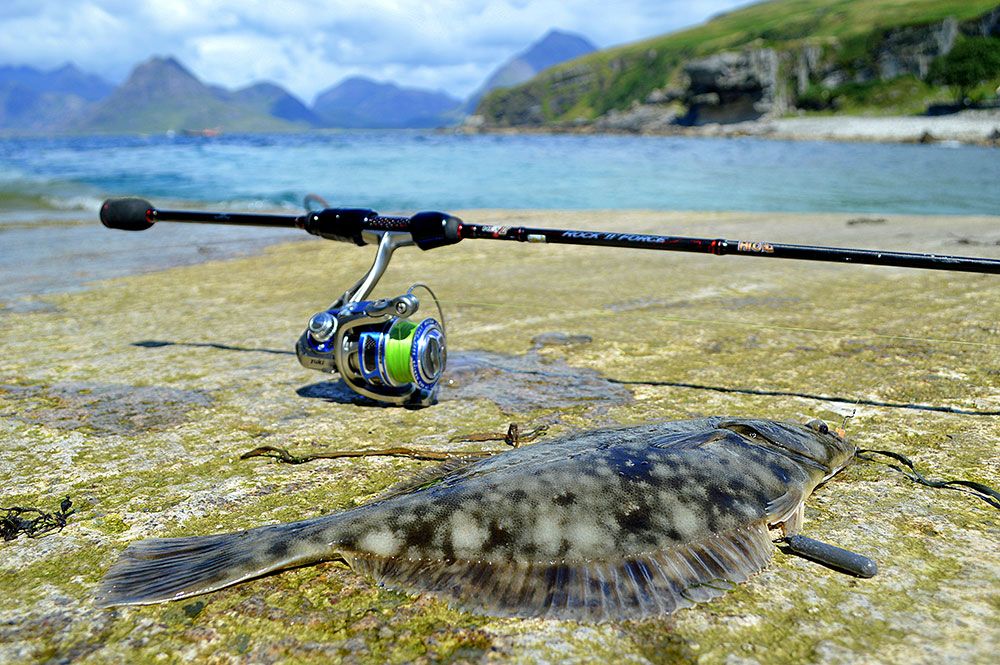
Tackle for light rock fishing for flatfish
When light rock fishing for flatfish, tackle does not need to be complicated. An LRF rod with a casting range of 1-8grams with either a solid or tubular tip, such as our HTO Hyper Sniper, will be enough to work the lure. Pair it with a spinning reel from 1000 to 3000 size and either braid or fluorocarbon mainline.
One of the many joys of flattie fishing is the fact that most of the areas you will be fishing will be over sand and mud. This means that you can use fine diameter mainlines such as a PE0.4 diameter braid or 3 or 4lb fluorocarbon without worrying about getting snagged. Fine diameter mainlines help when casting lighter jigheads as well as giving you extra distance when using heavier dropshotting gear.
I always use a fluorocarbon leader of 6-8lb when light rock fishing for flatfish, especially since I solely use braid, my leader of choice is YGK Nitlon DFC. If you are using a fluorocarbon mainline, then a leader will not be necessary.
A dropnet or long handled landing net is an invaluable tool to carry especially when fishing off harbour walls. I regularly catch flounder up to 3lbs in weight and these bigger fish are only able to be landed with a net. Trying to swing in a big flattie will most likely see the fish come off either through a hook pull or snapped leader or worse still snap the tip of your sensitive LRF rod. When fishing beaches or estuary it is easy enough to beach the fish with the help of a wave.
Polarised sunglasses. One item of equipment I find invaluable when fishing for flounders is polarised sunglasses. Most of my fishing for flounders tends to be in water shallow enough for me to see the seabed. Polarised sunglasses cut out the surface glare on the water and enable you to see fish as well as how your lure is working across the seabed. Above all else spending all day staring at the water without them can lead to eye damage, so it makes sense to fish with them on.
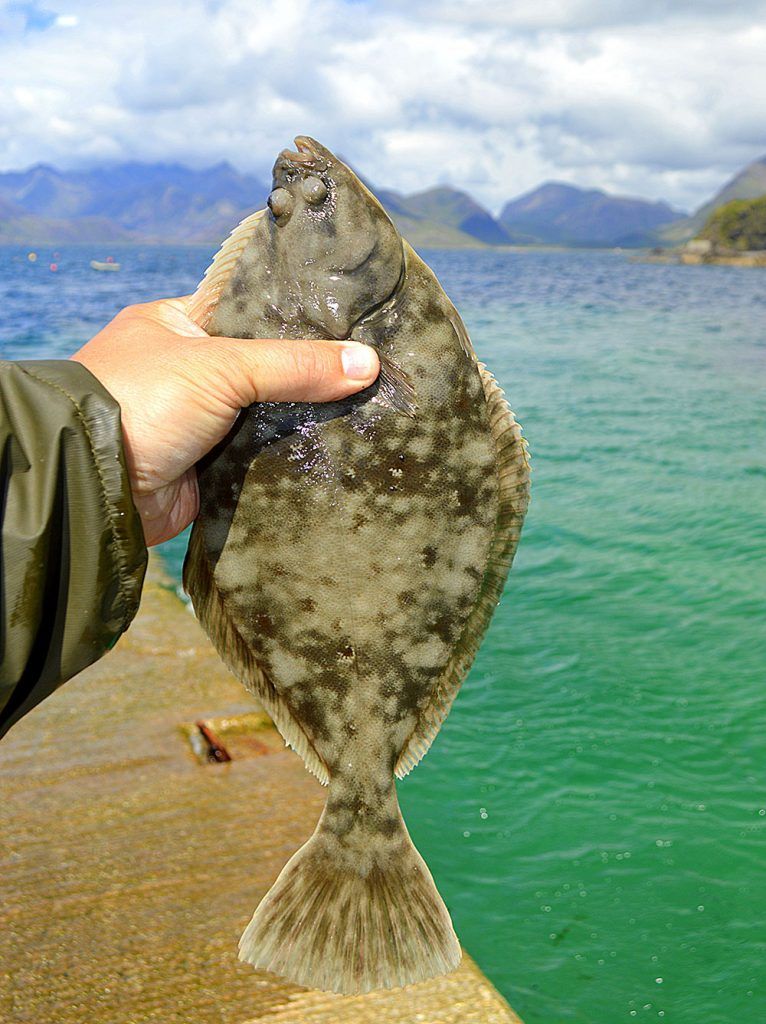
Lures for flatfish
One of my most successful lures when light rock fishing for flatfish are Marukyu Isome worms. These scented imitation ragworm are renowned for catching most fish that swim and flounder are no exception. They are also very handy for tipping metal lures with, which can be a great technique for summer flatties.
However, they are not the be all and end all of lures. The warm water makes the flatties very active so they will happily chase and grab a wide range of soft plastics. I like to carry a selection of slender lures to mimic sandeels such as the HTO Leethal. Small paddle tail shads like the HTO Tiny, Stink Pots or Mini Shads from 1-3 inches are useful to match bait fish and sprats. I also carry some HTO Bug-Ga and Paddle Bugs to imitate shrimps and crabs. I also like to carry a few mini metal lures, these are slim in profile to mimic sandeels like the HTO Fugitive, it also pays to carry a couple of spoons as well.
Terminal tackle for light rock fishing
I carry HTO Dropshot leads from 3.5g to 7g and a selection of hooks from #4 – #8. I also carry jig heads from 1g to 5g in the same hook size.
My two favourite methods when light rock fishing for flatfish are either a jig head rigged soft plastic or a dropshot rig. Both these methods are deadly for flatties. The jig head rig is more suited to close range fishing when its calm and the dropshot rig is great for fishing longer range or rougher seas due to being able to use a heavier weight.
Jig head rig
To work a jig head rig for flounder, mount your jig head with a soft plastic lure and cast out. Allow the lure to sink to the bottom, and then with a slow retrieve gently hop the lure back across the sea bed. Ideally you want to be able to feel your jig head trundling along the sea bed at all times. If you are fishing anywhere with a flow, try casting up flow and working the lure back along the sea bed with the flow. A strong current can lift your lure off the seabed when working against it and while you may get some flounder this way, I have found it more effective to keep the lure on the sea bed. Bites can come at any time and can be sudden but often you will feel a soft plucking at the lure. When you feel this pause for a couple of seconds to allow the bite to develop then strike to set the hook. Flounder will often kite towards you when hooked followed by a powerful dive back down when you get them under the rod tip, so hang on to your hat and enjoy the fight!
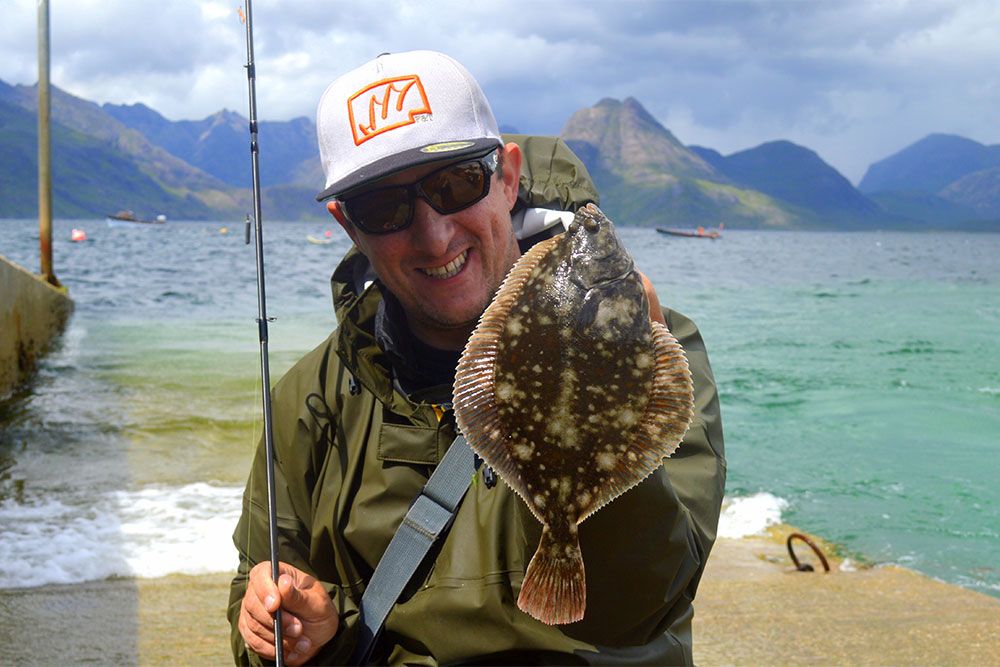
Dropshot rig
Tying the rig is very simple. I like to use a long shanked hook pattern for worm type lures from a #6 – #8, I favour a slim wire offset worm hook but a small Aberdeen also works well. Using a 4ft fluorocarbon leader tie your hook using a palomar knot 1ft from the bottom of the trace, then clip on a dropshot lead. Keep the weight of the lead within the casting range of the rod, I use anywhere from 3.5grams to 7grams depending on conditions. A purpose made dropshot lead will allow you to change the length of the drop, which means you can fish the lure at various distances from the sea bed. A dropshot lead will also come loose in the event of a snag and will allow you to retrieve your rig with the hook still in place.
The technique I use to work the rig is similar to how I work the jig head rig. Simply cast out and allow it to sink to the bottom, and then with the rod tip pointing down begin a slow retrieve all the time keeping the lead in contact with the seabed. As the lead trundles along the bottom it will throw up puffs of sand which helps attract the flounder and they will quickly home in on the lure waving seductively just off the sea bed. Again, when you feel a soft plucking at the lure drop the rod tip back toward the fish. This allows a little slack line which helps the flounder suck the lure into its mouth. Pause for a couple of seconds to let the bite develop. Then strike and set the hook.
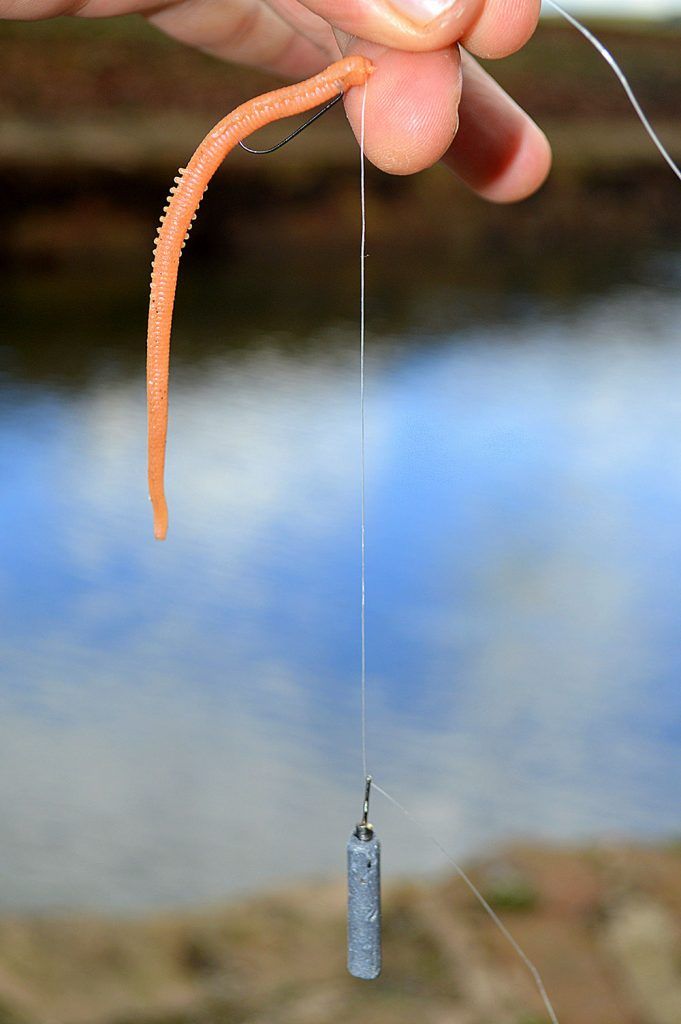
Metals
One of the oldest methods to target flounder is the good old baited flounder spoon. When light rock fishing for flatfish, this old-school approach can be brought bang up to date by using LRF mini metals!
The warm water makes the flounders much more energetic and they will happily take a small micro metal jig bounced along the sea bed. This lure and technique works very well especially when the flounder are hunting sand eels. I also like to tip the metal jigs with a small slender soft plastic for added attraction. I either add the soft plastic direct to the single hook on the jig or I swap the hook for a 3” length of line and attach the hook to that. Then I will tip it with a small soft plastic like a ragworm imitation or slender sand eel type.
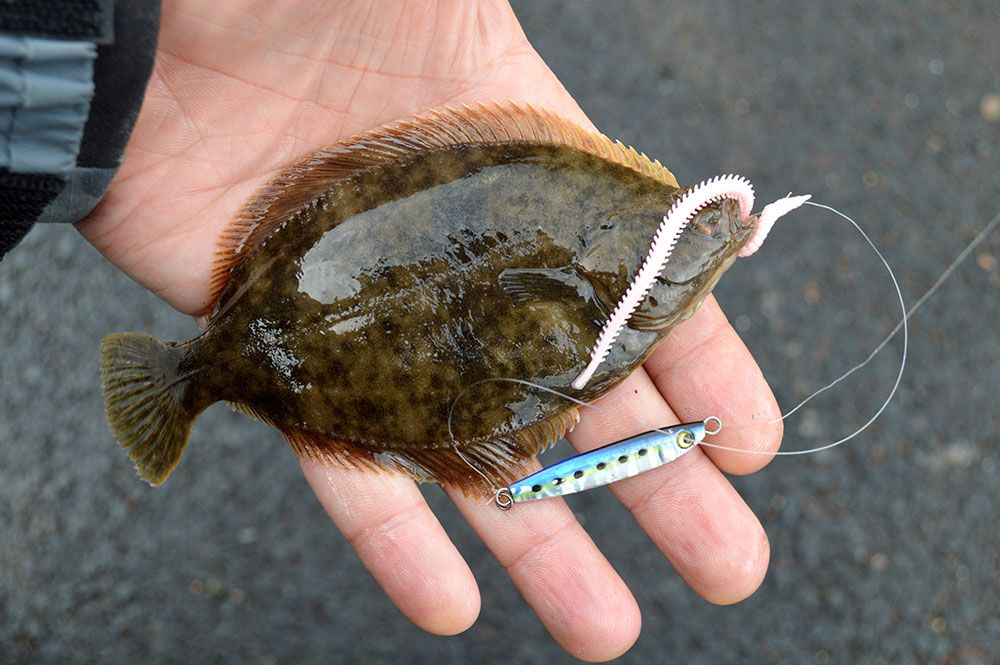
My main method for fishing metals for flatfish is to let the lure sink to the bottom, then retrieve the lure so that it skims across the sea bead. Fishing the lure within 6 inches from the bottom with little twitches should see your lure touching the sea bed now and again which throws up little puffs of sand. I try to imitate emerging sand eels or a struggling baitfish. I use the same slow retrieve technique for fishing metal jigs tipped with soft plastics and try to get the plastic working just on the sea bed throwing up puffs of sand whilst the metal lure waves a couple of inches from the sea bed. It also pays to add some pauses in to the retrieve as well. Stop retrieving and let your lure rest for a couple of seconds, flounder are a curious fish and will come to investigate your lure. When you start to retrieve again they will chase and hopefully grab the lure to stop it escaping.
Light Rock Fishing for Flatfish first appeared in Sea Angler Magazine.


